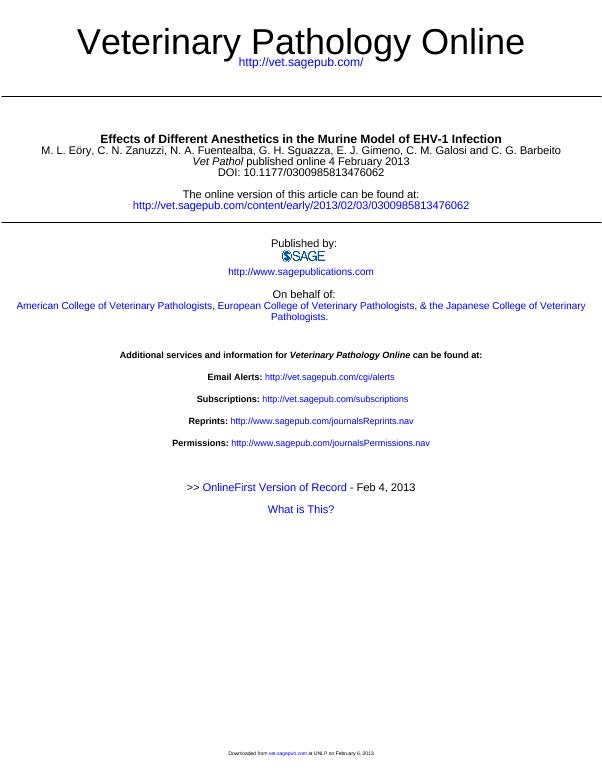Artículo
Effects of different anesthetics in the murine model of EHV-1 infection
Eöry, M. L.; Zanuzzi, Carolina Natalia ; Fuentealba, Nadia Analia
; Fuentealba, Nadia Analia ; Sguazza, Guillermo Hernán; Gimeno, Eduardo Juan
; Sguazza, Guillermo Hernán; Gimeno, Eduardo Juan ; Galosi, Cecilia Monica; Barbeito, Claudio Gustavo
; Galosi, Cecilia Monica; Barbeito, Claudio Gustavo
 ; Fuentealba, Nadia Analia
; Fuentealba, Nadia Analia ; Sguazza, Guillermo Hernán; Gimeno, Eduardo Juan
; Sguazza, Guillermo Hernán; Gimeno, Eduardo Juan ; Galosi, Cecilia Monica; Barbeito, Claudio Gustavo
; Galosi, Cecilia Monica; Barbeito, Claudio Gustavo
Fecha de publicación:
04/02/2013
Editorial:
American College of Veterinary Pathologists
Revista:
Veterinary Pathology
ISSN:
0300-9858
Idioma:
Inglés
Tipo de recurso:
Artículo publicado
Clasificación temática:
Resumen
Mice are commonly used as an experimental model to investigate the Equid herpesvirus 1 (EHV-1) infection. This model easily reproduces the disease, and the clinical signs are more or less similar to those observed in the horse, the natural host. During natural infection, the acute course of respiratory infection is mandatory for the development of adaptive immune response. Since interactions between EHV-1 and anesthetics are possible, the study investigated whether the early events of murine pulmonary immune response could be affected by different anesthetics. Therefore, mice were experimentally infected with a unique EHV-1 strain under the effects of ether, ketamine/xylazine, or isoflurane. Clinical signs and histopathological lesions in the lungs were described, and the cell death and proliferation rates of sham-inoculated or infected animals were quantified using immunohistochemistry. Clinical signs were more severe in animals anesthetized with ether. Qualitative differences in the recruited inflammatory cells were observed following application of anesthesia. The level of infection between the infected groups was not statistically significant. However, lungs from ketamine/xylazine-anesthetized animals showed the highest cell death rates, whereas those from isoflurane-anesthetized animals showed the highest proliferation rates. It has been emphasized that anesthetics alone or their interactions with EHV-1 modify the response against the infection. An appropriate selection of the anesthetic during experimental studies is relevant to minimize wrong conclusions.
Archivos asociados
Licencia
Identificadores
Colecciones
Articulos(CCT - LA PLATA)
Articulos de CTRO.CIENTIFICO TECNOL.CONICET - LA PLATA
Articulos de CTRO.CIENTIFICO TECNOL.CONICET - LA PLATA
Citación
Eöry, M. L.; Zanuzzi, Carolina Natalia; Fuentealba, Nadia Analia; Sguazza, Guillermo Hernán; Gimeno, Eduardo Juan; et al.; Effects of different anesthetics in the murine model of EHV-1 infection; American College of Veterinary Pathologists; Veterinary Pathology; 50; 5; 4-2-2013; 849-856
Compartir
Altmétricas



